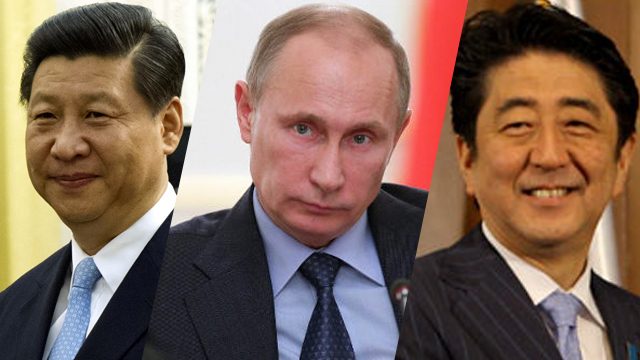SUMMARY
This is AI generated summarization, which may have errors. For context, always refer to the full article.

MEXICO CITY, Mexico – The leaders of China, Russia and Japan all descended on Latin America in recent weeks, jostling with the United States to increase their influence, invest and tap into resource-rich markets.
The latest arrival was Japanese Prime Minister Shinzo Abe, who on Monday, July 28, was in Trinidad and Tobago, the second stop on a five-country tour that began on Friday, July 25, in Mexico.
Abe’s visit began just as Chinese President Xi Jinping wrapped up his tour, which included stops in Brazil, Argentina, Venezuela and Cuba. Xi signed more than 100 trade agreements on the trip.
Russian President Vladimir Putin was in the region for a week from July 11, stopping in Argentina, Brazil, Nicaragua and Cuba.
The United States remains Latin America’s top trade partner, but gone are the days when Washington could take the region for granted as its backyard.
“In two or three more years, China will displace the European Union as the second most important trade partner of the region,” said Osvaldo Rosales, head of the international trade division a the Economic Commission for Latin America (ECLA), a United Nations agency.
“That probably explains prime minister Abe’s visit. For Japan and South Korea it is important to counterbalance the increased ties the region is establishing with China,” he told Agence France-Presse.
Even though Xi visited countries that denounce US “imperialism,” Rosales said his visit was “merely economic.”
“China needs the natural resources that allow it to maintain a long-term growth rate of five to seven percent,” the Chilean-born economist said.
China is in the market for Chilean copper and timber, Peruvian gold and zinc, Argentine beef and wheat, Brazilian sugar and soybeans and Venezuelan oil, among other commodities.
Yun Sun, East Asia expert at the Washington-based Stimson Center think-tank, said Xi’s trip partly sought to “strengthen China’s ties with Latin America, which is probably the weakest area in China’s global strategy.”
While China is boosting economic ties with the region, the Asian giant has a ways to go to catch up to the United States, whose trade with Latin America topped $800 billion in 2011, more than three times that of Beijing, according to the Council on Foreign Relations, a US think tank.
Challenging US dominance
Xi and Putin, who overlapped in Brazil, played to Latin American resentment toward perceived dominance of the region by Japan’s longtime ally the United States.
Together with Brazil, India and South Africa – their partners in the BRICS group of emerging nations – they announced a new $50 billion development bank and $100 billion reserve fund to rival the Western-dominated World Bank and International Monetary Fund.
Xi also wooed Latin American leaders by proposing a new $20 billion infrastructure fund for the region.
In communist Cuba, Xi signed deals on nickel and joint oil exploration in Cuban waters of the Gulf of Mexico.
Cuba is a regional bridgehead for foreign powers in the trade competition with the United States. Washington has had a economic embargo on the island since 1961, and the arrival of major US competitors shows that Latin nations no longer follow Washington’s wishes with ease.
“That Cuba can host Xi or Putin and sign agreements … is something that was absolutely unthinkable 10 or 15 years ago,” said Rosales. “It shows that we’re in a completely different international political context.”
Risks and opportunities
Russia’s trade with Latin America is not nearly as big as that of China, but Moscow may need support as the EU and the United States close their doors over the crisis in Ukraine.
Russia wants to use its role as a member of the BRICS group to increase ties in the region.
Latin America’s ties to the emerging powers comes with risks – as shown by its economic downturn following China’s post-financial crisis woes – but also new opportunities.
Rosales is convinced, for example, that economic reforms in China that focus on developing its internal market over exports will free up vast amounts of private capital for investment abroad.
Latin American nations are not yet doing enough to attract this capital, Rosales said. “This is an opportunity that we are letting slip by right now.” – Rappler.com
Add a comment
How does this make you feel?





There are no comments yet. Add your comment to start the conversation.